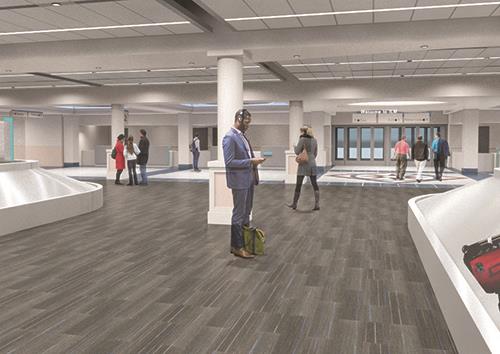Wilmington International Airport (ILM) in North Carolina has officially turned coronavirus lemons into lemonade. Fueled by vacation and business traffic alike, ILM crossed the 1 million passenger mark last year and was in the midst of a large terminal expansion project to accommodate its rising traffic when the COVID-19 pandemic hit in March.
 Wilmington International Airport (ILM) in North Carolina has officially turned coronavirus lemons into lemonade.
Wilmington International Airport (ILM) in North Carolina has officially turned coronavirus lemons into lemonade.
Fueled by vacation and business traffic alike, ILM crossed the 1 million passenger mark last year and was in the midst of a large terminal expansion project to accommodate its rising traffic when the COVID-19 pandemic hit in March.
A $9.8 million renovation to the ticketing lobby and baggage system was nearing completion; and site work was beginning in earnest on a $45 million terminal expansion that will add four new gates.
Both major initiatives were designed to eliminate pinch points that were hampering the on-time departure of early morning business flights, explains Airport Director Julie Wilsey.
|
facts&figures Project: Ongoing Terminal Expansion & System Improvements Location: Wilmington (NC) Int’l Airport Operator: New Hanover County Airport Authority Contract 2: Ticket lobby expansion; new outbound baggage makeup Original Timeline: April 2019 – Aug. 7, 2020 Anticipated Completion: July 10, 2020 Construction Costs: $9.24 million Funding: $9.1 million state grant; local funds
Contract 3: Terminal renovation; addition Contract 3/Schedule 1 Timeline: Jan. 2020 thru Jan. 2022 Contract 3/Schedule 2 Timeline: Jan. 2022 thru Jan. 2023 Construction Costs: $45.7 million Funding: Passenger facility charges; FAA funds; state grants; county loan; local funding Project Manager & Civil Engineer: Talbert & Bright Architect: The Wilson Group Architects General Contractor: Monteith Construction Structural Engineer & Building Geotechnical Engineer: Stewart Inc.
Mechanical, Electrical, Plumbing Baggage Handling Systems Consultant: BNP Associates Inc. Noteworthy Detail: Project team accelerated construction while passenger traffic was low during COVID-19 pandemic |
With three years of double-digit growth and the prospect for continued annual increases of at least 10%, the facility and staff were at times hard pressed to process 750 passengers per hour through TSA checkpoints and the airport’s antiquated, labor-intensive baggage makeup area.
And then the traffic stopped.
The lemons: In the first weeks of the pandemic, ILM’s passenger traffic dropped by 95%—from more than 50 flights a day by its three carriers (American Airlines, Delta Air Lines and United Airlines) to five each way.
The lemonade: During the state-imposed stay-at-home period, commercial construction projects were deemed “essential” activities, and work at the airport continued. In fact, drastically less passenger traffic allowed construction to proceed with fewer impediments. And, more construction crews are working on the terminal expansion than was originally planned.
“The pandemic has given us a little bit of breathing room,” Wilsey notes. “We can open up spaces and allow the contractors to do more work.”
As a result, the new ticket lobby may open in July—a month earlier than anticipated and at a slight savings for the airport. While it’s still too early to project whether contractors will finish the entire initiative before the January 2023 completion target, it’s now a distinct possibility.
Prior to North Carolina easing stay-at-home restrictions in May, not one case of COVID-19 had occurred at the airport or within the construction crews. Since then, however, one case was reported, and the worksite was temporarily shutdown.
March 2020
Granseur Dick, ILM’s facilities director, reports that work on a more spacious ticketing lobby with new ticket counters, space for a future fourth airline and self-service kiosks was 85% complete when flights stopped. New airline ticket offices were completed and crews had demolished the old offices to enable construction of ticket counters. Crews were just beginning to build out the new ticket counters and the finishing touches in the lobby.
When the virus first hit, the terminal expansion project was just 11% complete, Dick adds. A portion of the aircraft parking apron had been demolished to clear space, and crews were pouring foundations and support columns. The project is adding four new gates with passenger boarding bridges, new hold areas, restrooms and concessions.

The expansion, designed by architects from the Charlotte-based Wilson Group, is being constructed in two phases to minimize passenger inconvenience. The first part, or construction schedule for this phase, which adds a new concourse and other space in the main terminal, is scheduled to be complete in January 2022.
After the first schedule is complete, the existing connecting concourse will be demolished and the existing interior terminal space will be renovated to match the new facilities. “We want the airport to look seamless, so it looks like one facility,” notes Wilson Group President Brian Wilson. The design theme is an update of the airport’s original southern charm that reflects the growing Wilmington area, he notes.
A new, larger TSA security checkpoint with four lanes will be built in the new concourse.
The final work is expected to be complete in January 2023.

Change of Plans
In mid-March, passenger volume suddenly dropped to just 5% of March 2019 levels.
That’s what sparked the idea to accelerate some of the work already in progress.
Dick and other airport personnel met with the project team to revamp scheduling for select components, particularly flooring and finishes. Key participants were the builder, Monteith Construction; architect, The Wilson Group; and project engineer, Talbert & Bright.
 “The original plan took into account that we were trying to carry out a construction project in the interior space that was already at capacity,” Dick explains. “It presented a number of challenges that the engineers and contractors have overcome.
“The original plan took into account that we were trying to carry out a construction project in the interior space that was already at capacity,” Dick explains. “It presented a number of challenges that the engineers and contractors have overcome.
“We were going to break the project down into smaller footprints for the construction crews and we realized we had the opportunity to advance the project,” he continues. “We were able to take advantage of this unfortunate situation and combine some of the construction phases.”
Crews were able to operate more efficiently due to longer work hours during the day and more continuous construction zones, he details. And, with few passengers in the building, there were fewer restrictions on noise and the scope of work.
Installation of the new terrazzo floor is a specific case in point. Instead of dividing the expanded lobby into five installation zones to work around passengers, crews poured terrazzo in two larger zones. The result was a better product because there are fewer seams and joints, Wilsey notes.
Transitioning from the old baggage system to the new this summer will likely also be easier. Planners envisioned temporarily shutting down the system and using a porter service to carry the bags during the final phase. With lighter traffic, ILM will be able to leave the old system running longer, giving the project greater flexibility for the changeover.

Adapting to the New Situation
As the project builder, Wilmington-based Monteith took a three-prong approach to keeping work on track. The firm won all three contracts to serve as general contractor for ILM’s expansion as well as other recently completed projects, including installation of a new roof.
Monteith President Bryan Thomas says that it was paramount to take the right steps to protect the company’s employees and subcontractors. “We tried to see how we could best do this with social distancing.”
The company consequently divided its site managers and superintendents into two teams and added a second office trailer. This was a precautionary step so if someone on one team became ill it would not shut down the whole project. Monteith also coordinated with various team members and airport staff via conference calls, video meetings and emails to maintain physical separation.
Naturally, it was relatively easy for crews to “social distance” during outdoor work, but indoor tasks such as hanging drywall presented more challenges. Monteith procured masks in bulk, bought hand sanitizer in 100-gallon drums and installed hand-washing stations. It also hired a full-time site sanitizing company to clean frequently touched surfaces such as entry fencing and gates, scaffolding, equipment, tools and office spaces.
Additional portable toilets were rented. Instead of one unit for 20 employees, the company’s new ratio is one unit for four workers. And, some subcontractors brought in their own toilets.
Thomas estimates Monteith will spend about $40,000 more than usual on site safety—costs that will not be passed on to ILM. On balance, he says $40,000 of extra expenses is better than completely shutting the project down for a few weeks and then resuming.
The second portion of the company’s three-prong strategy was to ensure the financial stability of the subcontractors. Payment procedures were put in place to keep cash flowing to all the vendors.
The final prong was seeking opportunities to advance the project schedule.

Monteith had six projects elsewhere in the state that were either sidelined or reduced; so it re-deployed crews to the ILM projects. Some subcontractors were also able to beef up staffing at the airport.
 Thomas reports that there has been a 15% increase in construction staffing beyond the original plan. “It is always a challenge to get the number of subcontractors you want. You are always trying to gain a little bit of time because you don’t know when you will have a week of rain or hurricanes,” he relates. “We are getting the personnel as we need them a little easier now.”
Thomas reports that there has been a 15% increase in construction staffing beyond the original plan. “It is always a challenge to get the number of subcontractors you want. You are always trying to gain a little bit of time because you don’t know when you will have a week of rain or hurricanes,” he relates. “We are getting the personnel as we need them a little easier now.”
Crews working on the expansion project also had greater schedule flexibility because they could complete utility line shutoffs during the day without disrupting passengers.
While the lobby project may open as early as July 10, Thomas still expects more challenges. For example, the vendor building the ticket counter cabinetry had a COVID-19 “scare” that caused it to shut down operations and delay installation at the airport. “There are a lot of different parts and pieces yet to be put together,” Thomas notes.
Executives from Talbert & Bright, the project manager and engineer of record, consider it noteworthy that the project has actually gained momentum during the pandemic. “It is evident that the team has worked to lessen the impact of the coronavirus,” says company principal Steve Bright. “We are fortunate to have a design team and contractor that are exceptionally competent.”

Continuing Operations
Although traffic was markedly down, ILM was still operating as of press time in early June. “We have not reduced any of our staff and we remain open 24/7,” Wilsey reports.
Like the project’s construction crews, airport maintenance staff took advantage of the situation by performing deep cleaning at night. The staff also worked on small projects that had been delayed because of heavier traffic—sealing the parking lots, deep cleaning sidewalks, landscaping, etc. Concession operations were reduced because of fewer customers and the state-mandated closure of bars.

“We are now working to get people back,” says Wilsey. “We are encouraging masks in the terminal. It will take a confident traveler to come back to the airport and that will determine how quickly we recover.”
In early June, ILM’s passenger load had increased to 13% to 15% of similar periods in 2019.
|
Airport of the Future 2.0 Much was written about the “airport of the future” after the 9/11 terrorist attacks in 2001. Nearly 20 years later, it’s time for a new book, or at least a new chapter, to address the lasting changes associated with the coronavirus crisis.
“Right now at the security checkpoint you have switchbacks to keep people moving. With social distancing that does not work very well. What does a checkpoint look like when everyone has to be 6 feet apart?” he asks. New queuing configurations/processes will also have a big impact on the space needed for ticketing and boarding areas, he adds. As the industry begins to explore new ideas and concepts, Pence suspects that simple approaches like the taped lines on supermarket floors might be the answer. |


 Queuing passengers in the age of social distancing is one topic on the mind of Travis Pence, a partner in The Wilson Group architectural firm.
Queuing passengers in the age of social distancing is one topic on the mind of Travis Pence, a partner in The Wilson Group architectural firm.

